Overview
The article outlines ten effective employee retention strategies that enhance engagement, including:
- Tailored recruitment
- Effective onboarding
- Mentorship programs
- Flexible work arrangements
Each strategy is substantiated by compelling evidence demonstrating its impact on job satisfaction and loyalty. For instance, research indicates that companies investing in professional development and recognition programs significantly reduce turnover rates and foster a positive workplace culture. By implementing these strategies, organizations can not only improve employee retention but also cultivate an environment where employees feel valued and engaged.
Key Highlights:
- Boutique Recruiting focuses on aligning employer and candidate needs for better cultural fit, leading to improved employee retention.
- Effective onboarding processes are essential for new hires, fostering belonging and reducing turnover.
- Mentorship programs enhance professional growth and connection, with 98% of Fortune 500 companies implementing them.
- Investing in professional development increases job satisfaction and retention, with U.S. firms spending $10.1 billion on training in 2023.
- Employee recognition programs foster a culture of appreciation, significantly reducing turnover rates.
- Flexible work arrangements improve job satisfaction and help attract and retain talent.
- Continuous feedback between managers and staff enhances engagement and loyalty.
- Providing competitive benefits demonstrates a commitment to employee well-being, crucial for retention.
- Cultivating a positive company culture that emphasizes inclusivity and respect is vital for staff retention.
- Promoting work-life balance through flexible policies leads to higher employee satisfaction and loyalty.
Introduction
In a competitive job market where employee retention is paramount, organizations are compelled to seek innovative strategies that keep their workforce engaged and committed. Consider the multifaceted approach required to enhance employee satisfaction:
- Tailored recruitment solutions that align candidates with company culture
- Comprehensive onboarding processes that foster a sense of belonging
- Mentorship programs
- Professional development opportunities
- Robust recognition initiatives
By implementing these strategies, businesses can cultivate an environment where employees feel valued and supported. Furthermore, the integration of flexible work arrangements and continuous feedback mechanisms can significantly bolster employee loyalty. This article delves into effective strategies that organizations can adopt to improve retention rates, ensuring a motivated and dedicated workforce that drives long-term success.
Boutique Recruiting: Tailored Recruitment Solutions for Employee Retention
Boutique Recruiting excels in aligning the unique needs of employers and candidates, ensuring optimal fit from the outset. By prioritizing cultural alignment alongside specific job requirements, the firm not only facilitates successful placements but also provides employee retention strategies examples that improve staff retention. This tailored method fosters a sense of belonging among staff, which is essential for long-term dedication. Research indicates that employee retention strategies examples, like offering perceived career advancement, can lead to workers being 20% more likely to remain with their companies throughout the year. Boutique Recruiting actively promotes this advancement by providing customized career development opportunities and continuous assistance, ensuring candidates are not only technically qualified but also in harmony with the company values.
Testimonials from satisfied clients underscore this commitment:
- “Boutique Recruiting managed the recruiting process extremely well with great follow-up and communication every step of the way,” noted Ashley Madigan from the San Diego Symphony Orchestra.
Furthermore, organizations that utilize employee retention strategies examples experience significantly lower turnover rates—21% less for high-turnover environments and 51% less for low-turnover settings, as highlighted by Gallup. Boutique Recruiting’s dedication to quality and personalized service guarantees that candidates resonate with the company culture, effectively reducing turnover rates.
Additionally, by simplifying exit interviews, the firm gains valuable insights into turnover reasons, allowing for continuous improvement in their recruitment strategies. This strategic emphasis on cultural compatibility is crucial in today’s competitive employment landscape, where employee retention strategies examples can lead to enhanced employee loyalty and overall workplace satisfaction. Insights from case studies, such as the one titled ‘Improving Workforce Engagement,’ further illustrate how addressing worker needs and experiences can significantly enhance loyalty rates. For Financial Firm HR Managers, implementing these tailored recruitment solutions can lead to a more engaged workforce and lower turnover, ultimately benefiting the organization as a whole.
BetterUp: Enhance Onboarding to Boost Employee Retention
A comprehensive onboarding process is essential for fostering staff retention and engagement. Organizations like BetterUp highlight that effective onboarding extends beyond basic orientation; it involves equipping new hires with the necessary tools, resources, and support to thrive from their first day. This method fosters a sense of belonging and dedication, which is essential in today’s competitive job market where, according to recent news, 65% of workers feel assured they can find higher-paying positions elsewhere. This statistic underscores the urgent need for effective onboarding to retain talent.
Key elements of a successful onboarding program include:
- Mentorship opportunities
- Structured training sessions
- Regular check-ins
These practices not only help new staff feel appreciated but also promote their integration into the company culture. A recent survey revealed that 83% of staff believe having a robust onboarding program would significantly benefit their transition into a new role. Moreover, statistics from a Gallup study indicate that only 29% of new hires feel adequately supported and prepared to excel in their positions. This emphasizes the outcomes of insufficient onboarding and the significance of a well-organized procedure that prioritizes staff engagement and loyalty.
Furthermore, establishing a contemporary intranet can simplify the onboarding procedure and improve staff engagement, offering a useful resource for HR leaders, and utilizing employee retention strategies examples, such as thorough onboarding strategies, can help companies boost their loyalty rates and foster a more dedicated workforce. To effectively implement these strategies, HR managers should consider developing a structured onboarding plan that includes mentorship, regular feedback, and the use of technology to facilitate communication and training.
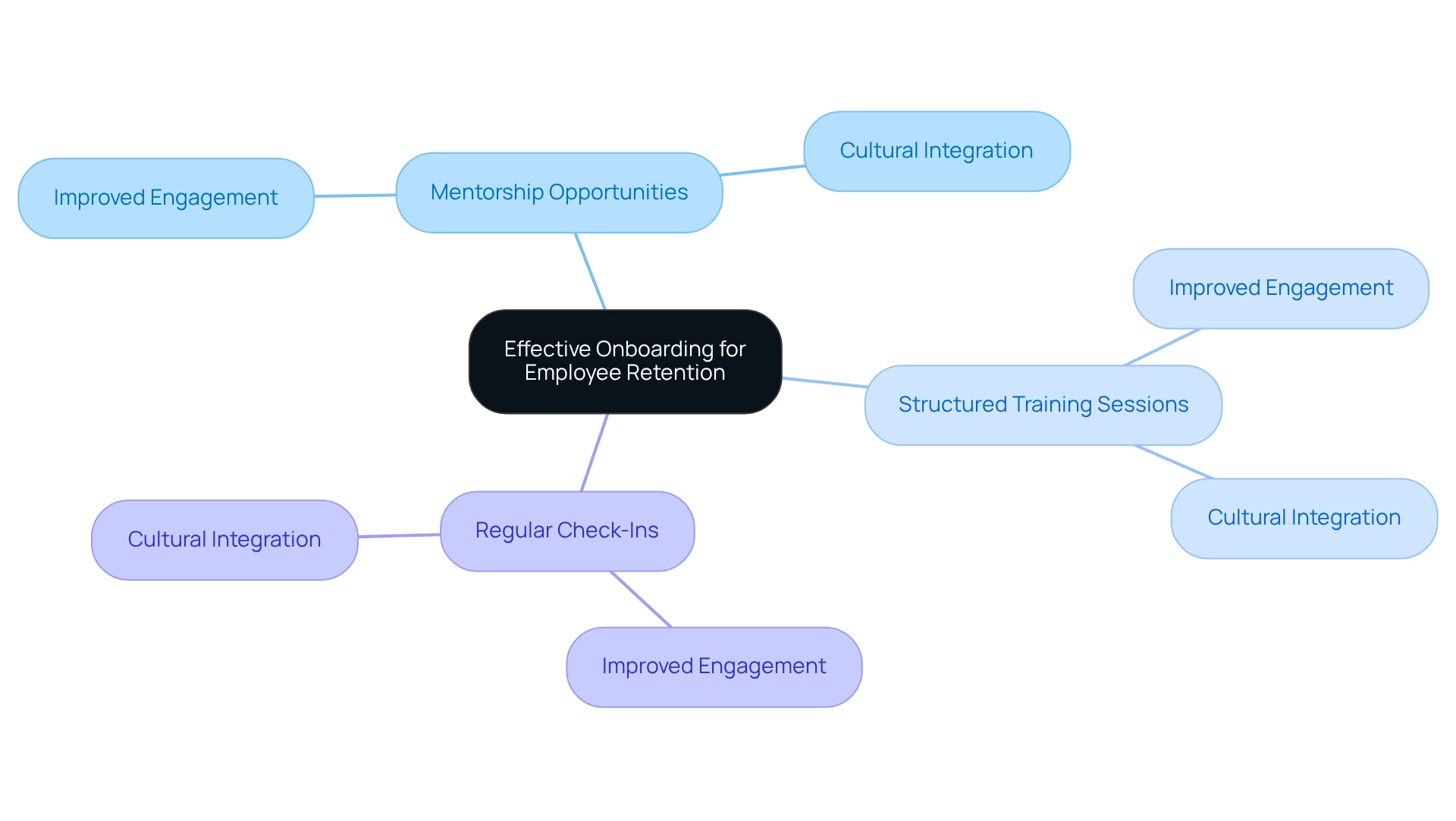
Robert Half: Implement Mentorship Programs for Employee Growth
Establishing mentorship programs is a powerful strategy and serves as one of the employee retention strategies examples for enhancing staff retention and job satisfaction. By pairing seasoned staff with recent recruits, companies create a supportive atmosphere that encourages professional growth and development. This relationship not only assists staff in navigating their career paths but also provides them with essential skills, fostering a greater sense of connection to the organization.
Statistics reveal that an impressive 98% of Fortune 500 companies implement formal and structured mentoring programs, underscoring their effectiveness in promoting employee engagement. In fact, 88% of mentees report increased productivity, as mentors motivate and hold them accountable. This dynamic not only enhances individual performance but also contributes to a positive workplace culture.
Effective mentorship programs are important employee retention strategies examples that have demonstrated substantial effects on keeping employees. Ongoing evaluation of these programs is crucial for assessing their effectiveness and making necessary adjustments. By establishing consistent feedback systems, organizations can enhance their mentorship approaches, resulting in greater satisfaction for both mentors and mentees, which serves as effective employee retention strategies examples.
Expert insights emphasize that everyone, regardless of their position, can benefit from a coach’s guidance. As Tony Robbins aptly states, “Everyone needs a coach, whether it’s a top-level executive or a graduate student.” This viewpoint emphasizes that mentorship is a crucial element of staff development, ultimately resulting in enhanced job satisfaction and loyalty rates. To successfully execute mentorship initiatives, HR managers should contemplate:
- Setting clear goals
- Offering training for mentors
- Consistently evaluating the program’s influence on staff engagement and loyalty
Sparkbay: Create Professional Development Opportunities
Organizations must prioritize a diverse array of professional development opportunities, including workshops, training sessions, and access to online courses. Investing in workers’ skills not only enhances job satisfaction but also indicates a commitment to their development—a crucial factor in retention. Indeed, a notable 74% of staff indicate that they are not achieving their full potential due to insufficient development opportunities, highlighting the urgent need for extensive learning options.
Moreover, companies are increasingly acknowledging the significance of investing in staff development. In 2023, U.S. firms spent $10.1 billion on external training products and services, up from $8.2 billion in 2022. This growing investment underscores the importance of development strategies in retention efforts. For instance, a manufacturing firm that implemented a targeted training program focused on skill enhancement and operational efficiency experienced a 12% increase in production output and a 20% reduction in errors. This illustrates the direct correlation between training initiatives and improved performance.
Furthermore, organizations that strategically invest in staff development report 11% greater profitability and are twice as likely to retain their workforce, as noted by Steven Zauderer. The effect of training programs extends beyond short-term job performance; they significantly enhance staff engagement and satisfaction. By cultivating an environment where ongoing education is promoted, organizations can develop a more driven and dedicated workforce, ultimately resulting in enhanced employee loyalty. Successful employee retention strategies examples rely on the effective implementation of training and development programs, making them indispensable in today’s competitive job market. Are you ready to elevate your organization’s approach to employee development?
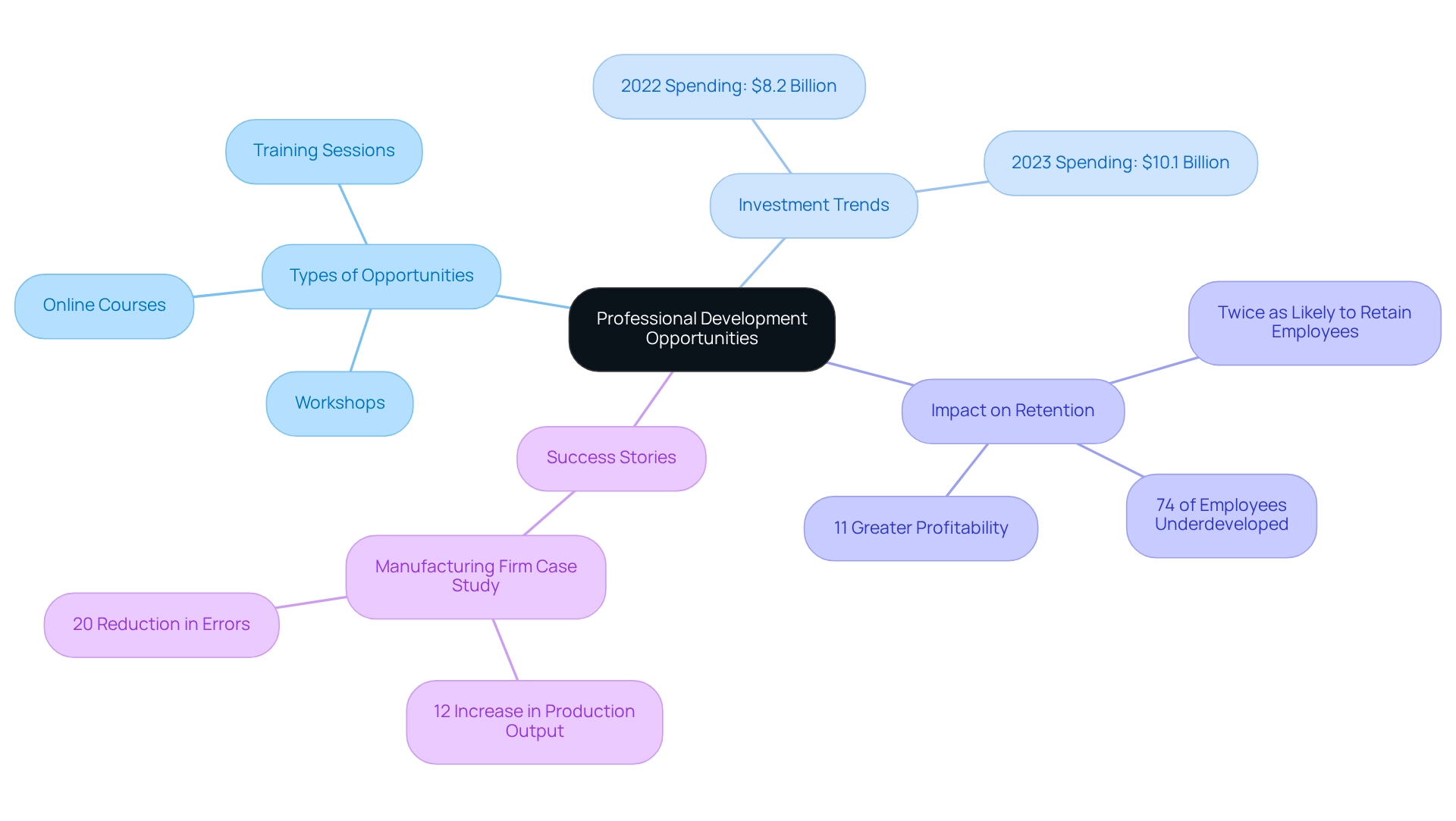
Astron Solutions: Establish Employee Recognition Programs
Implementing staff recognition programs is essential for fostering a positive work environment and enhancing engagement. Consistent recognition of accomplishments—whether via formal awards or informal praise—fosters a culture of appreciation that motivates individuals to stay dedicated to their positions. Studies show that insufficient acknowledgment can double the chances of staff turnover, emphasizing the necessity for regular and impactful employee retention strategies examples, as seen in successful firms such as Zappos, GE, and Apple, which have proven the effectiveness of organized recognition programs in reducing attrition and enhancing loyalty rates. These entities have demonstrated that when staff members feel appreciated, they are more inclined to remain involved and dedicated to their employers. In fact, O.C. Tanner states that 37% of staff have never been acknowledged by their employer, which greatly affects staff continuity and offers a considerable chance for enhancement within financial firms.
To effectively lower turnover, organizations should think about introducing weekly feedback meetings to acknowledge staff contributions. This practice not only motivates average performers but also reinforces a culture of continuous improvement and engagement. Financial firms could adopt employee retention strategies examples, such as specific recognition programs like peer-to-peer recognition platforms or monthly awards for outstanding performance, to create a more supportive and engaging workplace. By reevaluating recognition strategies based on staff feedback—particularly during offboarding—employers can improve their retention rates and cultivate a more dedicated workforce.
Human Resources Today: Offer Flexible Work Arrangements
Human Resources Today asserts the necessity of flexible work arrangements, including remote work options and adaptable hours, as integral components of effective recruitment strategies. These arrangements empower employees to harmonize their personal and professional lives, thereby fostering enhanced job satisfaction and alleviating stress. Organizations that prioritize flexibility not only bolster workforce satisfaction but also position themselves as desirable employers within the competitive talent landscape.
Boutique Recruiting underscores the critical importance of embedding such flexible policies into tailored recruitment solutions for technical and HR roles. This approach ensures that companies can attract and retain top talent by utilizing employee retention strategies examples that prioritize autonomy and work-life balance.
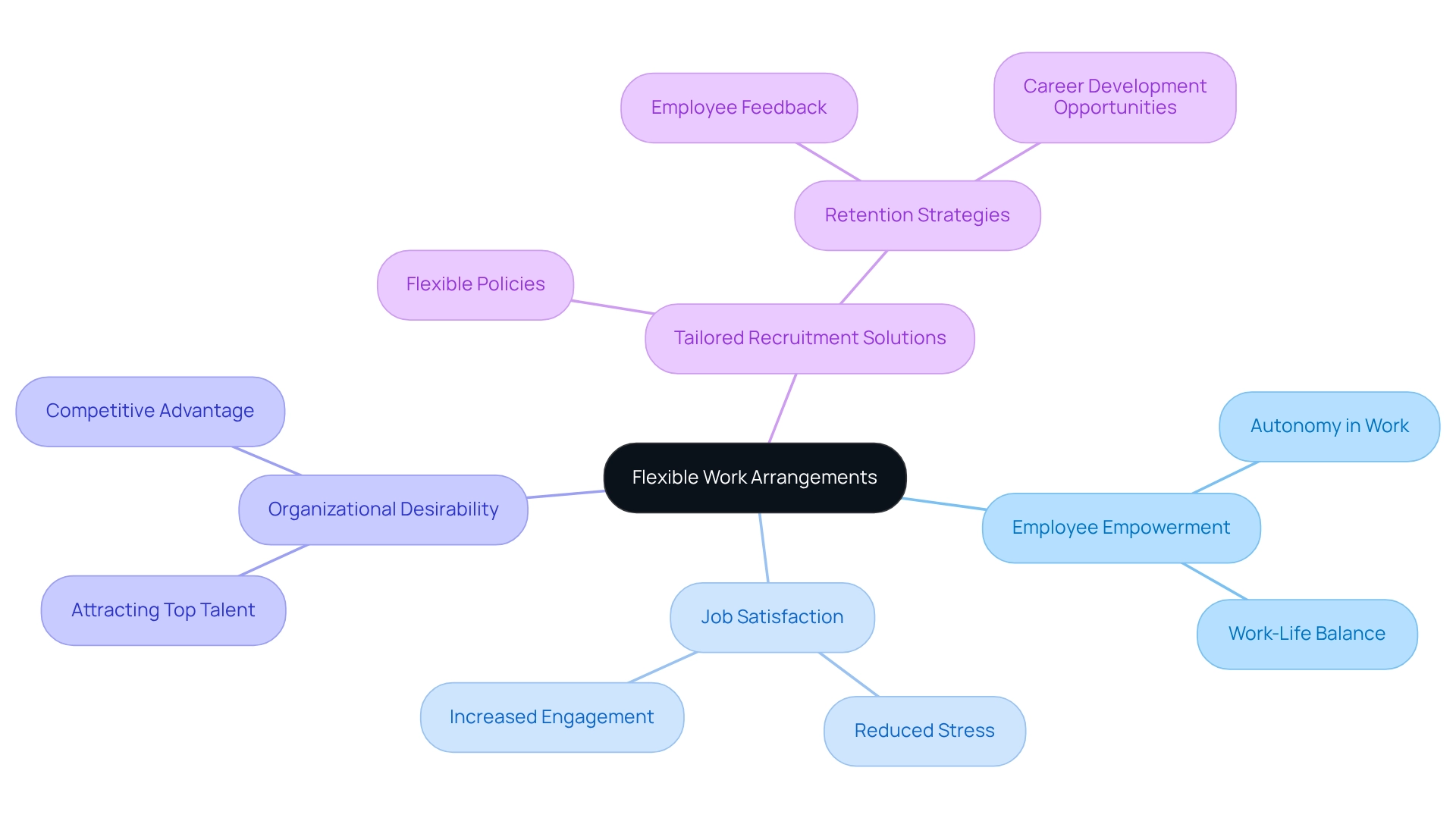
AIHR: Foster Continuous Feedback for Employee Engagement
Nurturing a culture of ongoing feedback is crucial for companies striving to improve staff engagement and loyalty. Regular check-ins between managers and staff create an environment where concerns can be addressed promptly, facilitating personal and professional growth. This continuous conversation not only enhances involvement but also reinforces staff dedication to the company, illustrating effective employee retention strategies examples that result in higher retention rates.
Research indicates that organizations prioritizing open communication demonstrate effective employee retention strategies examples, resulting in a marked increase in staff satisfaction and loyalty. A robust feedback environment maintains the feedback loop active and efficient, ensuring that staff feel acknowledged and appreciated.
As Kailash, a Content Marketer, notes, ‘In organizational contexts, it helps correct behaviors and processes by providing corrective feedback, fostering continuous improvement, adaptability, and long-term operational efficiency.’ By establishing a strong feedback environment, companies can create effective employee retention strategies examples that foster a more engaged workforce, ultimately propelling organizational success.
Dr. Veldsman highlights that HR plays a pivotal role in nurturing individual potential, positioning itself as a catalyst for growth rather than merely a resource manager. This approach not only benefits the organization but also enhances staff fulfillment, creating a win-win scenario for both parties.
The case study titled ‘Unlocking Individual Potential’ illustrates how nurturing individual abilities leads to both organizational success and staff satisfaction, reinforcing the importance of a feedback-driven culture.
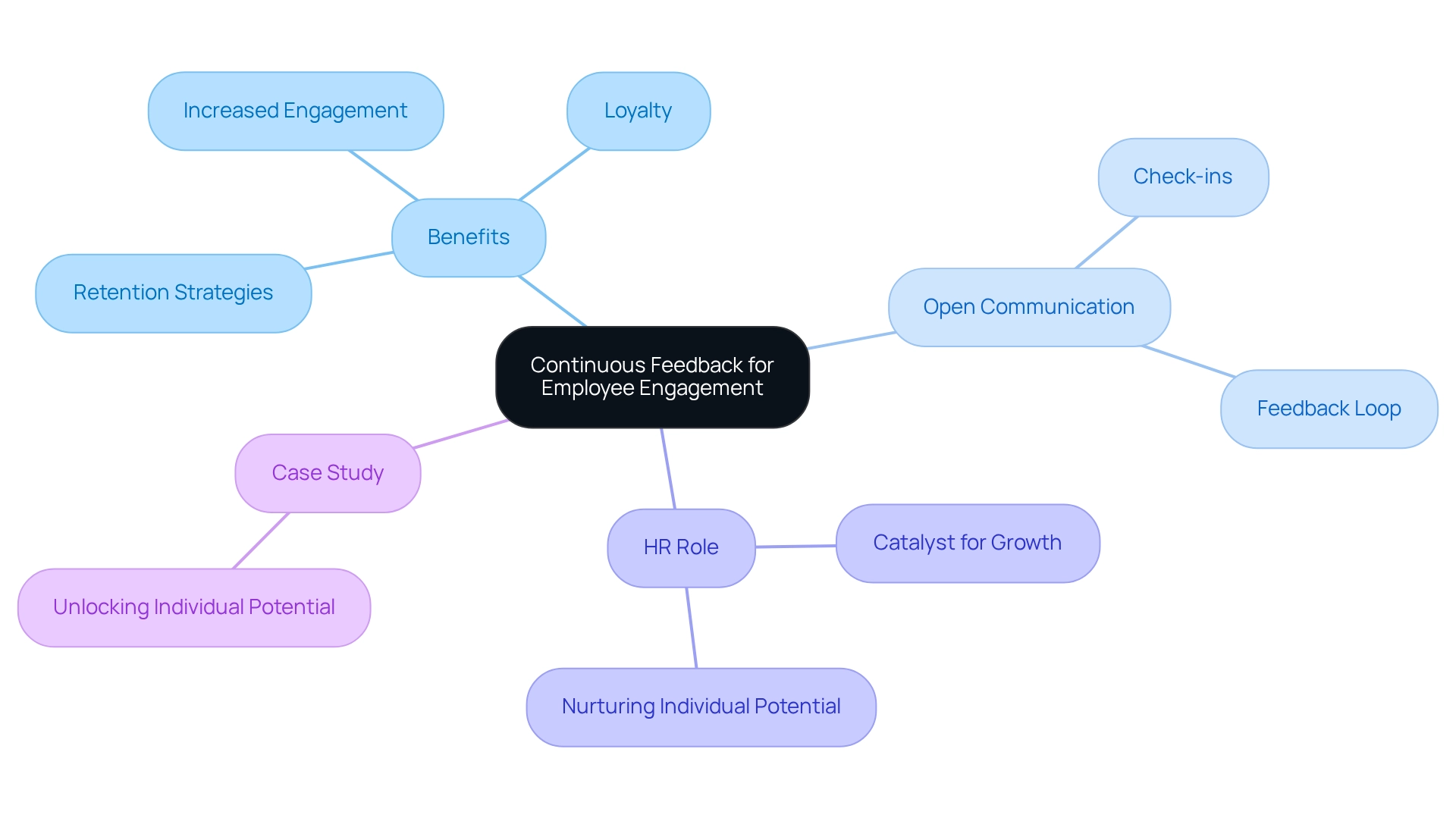
ClearCompany: Provide Competitive Benefits to Retain Talent
Providing competitive benefits is essential for attracting and retaining top talent, as emphasized by ClearCompany. A comprehensive benefits package—including health insurance, retirement plans, and wellness programs—addresses the varied needs of staff. While not every benefit can be provided, focusing on strategic perks serves as a solid foundation for employers. Such employee retention strategies examples not only enhance job satisfaction but also demonstrate a company’s commitment to staff well-being, which is crucial for retention.
In fact, the average spending on benefits per staff member in private organizations is $38.61 per hour, underscoring the financial investment companies make to enhance worker satisfaction. Moreover, a study disclosed that 57% of employers encounter difficulties in informing staff about their benefits. This suggests that enhanced communication can lead to greater utilization and satisfaction. This is backed by the case study titled “The Role of Education in Benefits Management,” which emphasizes the importance of informing staff about their benefits.
Additionally, tax incentives for certain contributions, such as health insurance and retirement benefits, can further enhance the attractiveness of benefits packages. Consequently, entities that prioritize strong benefits packages are more likely to adopt employee retention strategies examples, resulting in decreased turnover and heightened loyalty among their workforce. Significantly, 32% of workers receive commissions, highlighting the variety of benefits that can meet different staff needs.
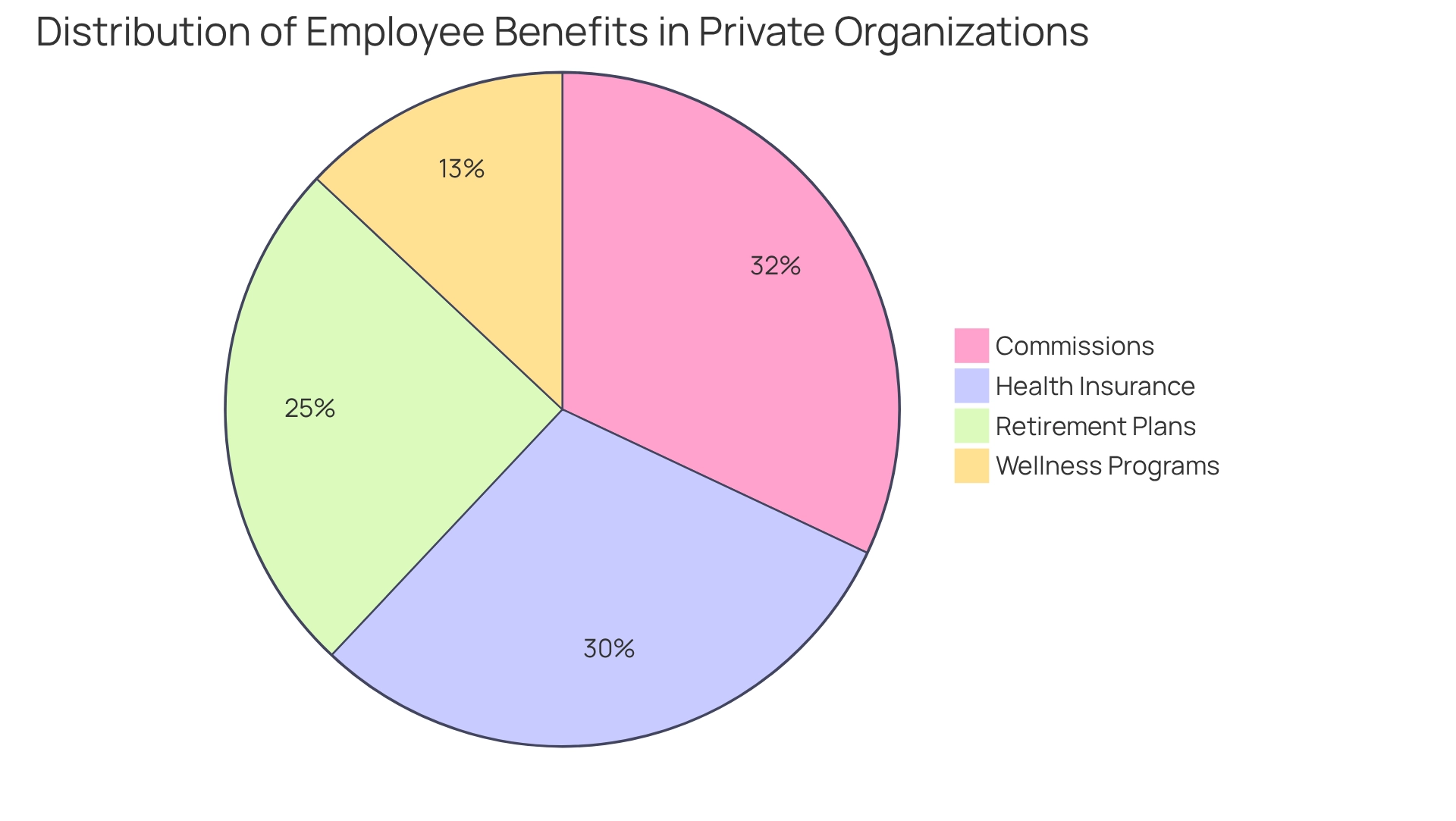
Quantum Workplace: Cultivate a Positive Company Culture
Fostering a positive workplace environment is crucial for businesses that implement employee retention strategies examples to enhance staff retention. A workplace that emphasizes inclusivity, respect, and collaboration cultivates a sense of belonging among staff, which is essential for sustaining high morale and minimizing turnover. Alarmingly, studies reveal that 82% of staff believe their work environment lacks fairness, underscoring the necessity for businesses to proactively address these disparities.
Firms that promote diversity and inclusion (D&I) not only drive innovation but also nurture a culture where individuals feel valued. For instance, organizations that integrate D&I values into their recognition initiatives have reported significant improvements in workforce engagement and overall success. This strategy not only attracts top talent but also aligns with the organization’s core values, reinforcing a positive work environment. By implementing D&I initiatives, financial firms can cultivate a more inclusive atmosphere that directly supports their employee retention strategies examples, as expert insights affirm that a robust organizational atmosphere directly influences staff engagement and retention. Timothy R. Clark’s framework, The 4 Stages of Psychological Safety, illustrates how fostering environments of inclusion and innovation can enhance staff satisfaction. By nurturing an atmosphere of respect and inclusivity, organizations can markedly improve their ability to retain talented individuals. As firms strive to create workplaces where everyone feels they belong, achieving certifications like Great Place To Work® can serve as a testament to their commitment to fostering a supportive environment, ultimately assisting leaders in achieving their business objectives.
Looking ahead to 2025, the emphasis on positive company culture will be more critical than ever, as businesses increasingly recognize its impact on staff satisfaction and loyalty. By implementing employee retention strategies examples that promote collaboration and inclusivity, financial firms can not only bolster employee loyalty but also cultivate a workforce that is engaged and motivated to contribute to the company’s success.
Robert Half: Promote Work-Life Balance for Employee Retention
Encouraging work-life balance is crucial for companies seeking to improve staff commitment. Effective employee retention strategies examples include:
- Flexible work arrangements
- Encouragement of time off
- Support for personal commitments
These strategies foster a culture valuing work-life balance. This method not only enhances worker satisfaction but also fosters loyalty, significantly lowering turnover rates. Statistics show that organizations offering continuous access to wellbeing resources, such as Assistance Programs, during parental leave experience better outcomes in keeping staff. Specifically, companies that maintain these resources during parental leave report a notable increase in workforce stability rates.
For instance, Novartis Australia and New Zealand implemented a family-friendly workplace initiative that included an upgraded parental leave policy and flexible working arrangements. This initiative not only increased engagement but also led to higher retention rates, with a significant rise in fathers taking parental leave, demonstrating the effectiveness of employee retention strategies examples.
Caitriona Comerford, Executive Director of People at Multiplex, emphasized the significance of becoming accredited as a family-inclusive workplace, which reflects a broader trend towards inclusivity in workforce management. By prioritizing work-life balance and implementing supportive policies, organizations can create an environment where individuals feel valued and supported, ultimately enhancing job satisfaction and loyalty. Furthermore, the development of a new Domestic Violence policy highlights the commitment to employee wellbeing, reinforcing the importance of comprehensive support systems in fostering a positive workplace culture.
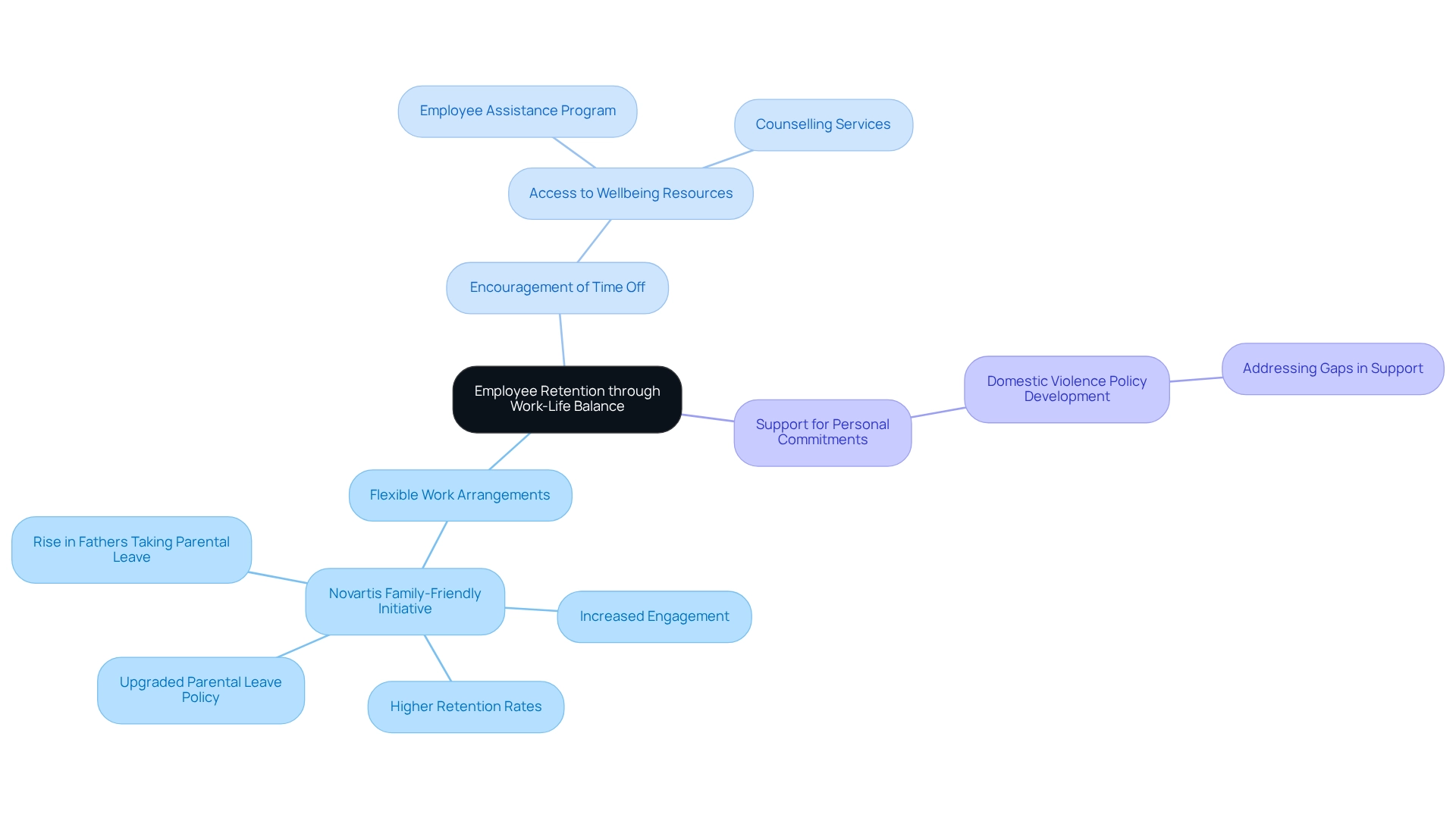
Conclusion
Implementing effective strategies to enhance employee retention is essential for organizations aiming to excel in today’s competitive job market. The article underscores several pivotal approaches:
- Tailored recruitment solutions that prioritize cultural fit
- Comprehensive onboarding processes that foster a sense of belonging
- Mentorship programs that facilitate professional growth
- Providing opportunities for professional development
- Establishing recognition initiatives
- Promoting work-life balance
These are critical components for cultivating a motivated and engaged workforce.
By embracing these strategies, organizations can markedly elevate employee satisfaction and loyalty. Evidence indicates that employees who feel valued and supported are more likely to remain committed to their roles, thereby reducing turnover rates and fostering long-term success. Moreover, nurturing a positive company culture that emphasizes inclusivity and open communication can further amplify retention efforts.
Ultimately, the integration of these practices not only benefits individual employees but also bolsters the overall success and stability of the organization. As companies prioritize employee engagement and well-being, they position themselves more favorably to attract and retain top talent, ensuring a dedicated workforce that propels their mission forward. Now is the time for organizations to invest in their most valuable asset—their people—by implementing these effective retention strategies.
Frequently Asked Questions
What is the primary focus of Boutique Recruiting?
Boutique Recruiting focuses on aligning the unique needs of employers and candidates by prioritizing cultural alignment alongside specific job requirements to ensure optimal fit and successful placements.
How does Boutique Recruiting contribute to employee retention?
The firm provides employee retention strategies such as perceived career advancement and customized career development opportunities, which foster a sense of belonging among staff, ultimately improving retention rates.
What evidence supports the effectiveness of employee retention strategies?
Research indicates that employees who perceive opportunities for career advancement are 20% more likely to stay with their companies, and organizations using employee retention strategies experience significantly lower turnover rates.
How does Boutique Recruiting gather insights into turnover reasons?
By simplifying exit interviews, Boutique Recruiting gains valuable insights into the reasons for turnover, allowing for continuous improvement in their recruitment strategies.
What role does effective onboarding play in staff retention?
Effective onboarding fosters staff retention and engagement by equipping new hires with the necessary tools, resources, and support, which helps them feel a sense of belonging and dedication from their first day.
What are key elements of a successful onboarding program?
Key elements include mentorship opportunities, structured training sessions, and regular check-ins, which help new staff feel appreciated and promote their integration into the company culture.
What statistics highlight the importance of onboarding?
A survey revealed that 83% of staff believe a robust onboarding program would benefit their transition, and only 29% of new hires feel adequately supported in their positions.
How can mentorship programs enhance employee retention?
Mentorship programs pair seasoned staff with new recruits, creating a supportive atmosphere that encourages professional growth, enhances job satisfaction, and fosters a greater sense of connection to the organization.
What percentage of Fortune 500 companies utilize mentorship programs?
An impressive 98% of Fortune 500 companies implement formal and structured mentoring programs, highlighting their effectiveness in promoting employee engagement.
What should HR managers consider when implementing mentorship initiatives?
HR managers should set clear goals, offer training for mentors, and consistently evaluate the program’s impact on staff engagement and loyalty.
